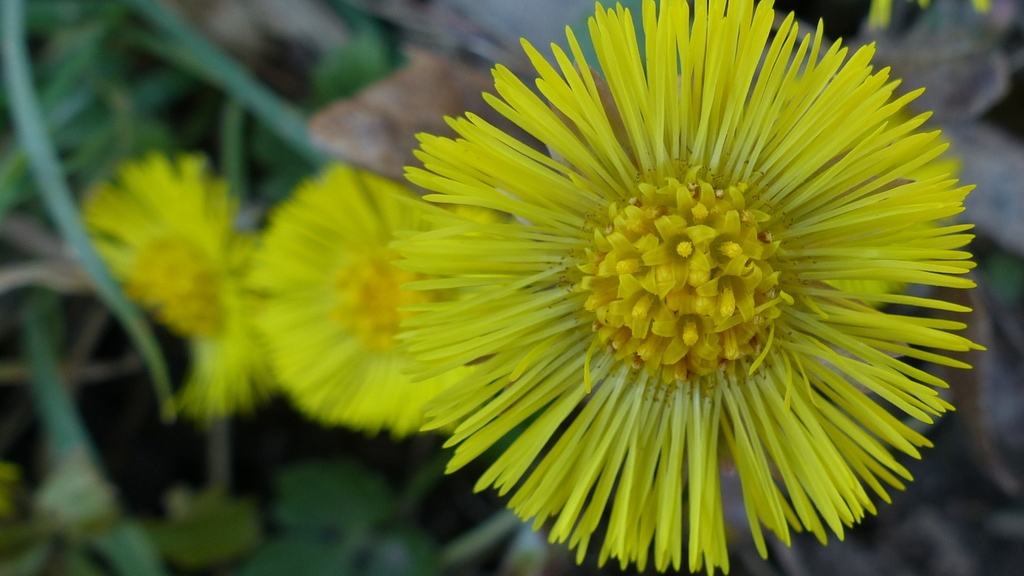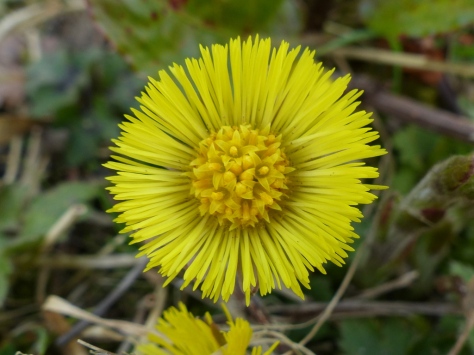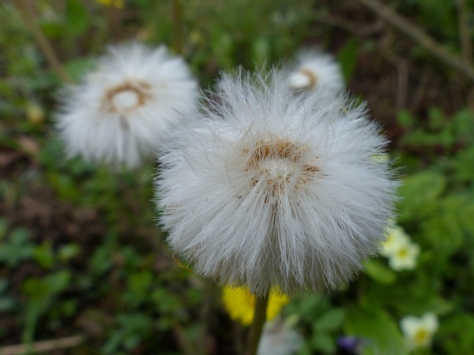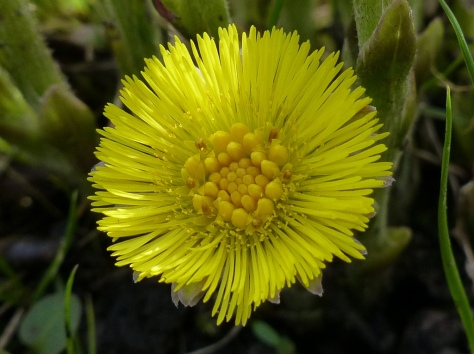 A member of the Daisy family, Coltsfoot is a composite flower head made up of central disc florets (male) and thin, radial, ray florets (female).
A member of the Daisy family, Coltsfoot is a composite flower head made up of central disc florets (male) and thin, radial, ray florets (female).
 It is native to the UK, Europe, North Africa and Western and North Asia it is an introduced species in North America.
It is native to the UK, Europe, North Africa and Western and North Asia it is an introduced species in North America.
In many parts of the world it is the first spring flower to appear and in Finland the first Coltsfoot is routinely reported in the media, signalling the end of a long winter and the coming of spring. Something that everybody looks forward to.
Early flowering is achieved because the flower heads form in the previous autumn, lie dormant through the winter and are ready to open at the first sign of spring.
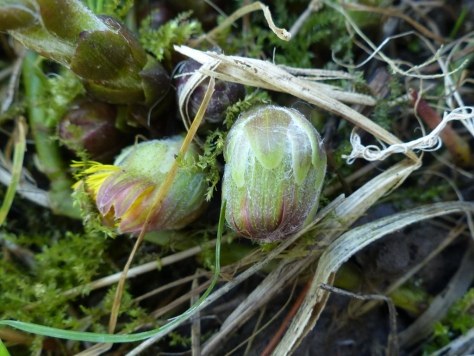 Coltsfoot flowers appear long before the leaves. The leaves only appear after the flowers have gone to seed.
Coltsfoot flowers appear long before the leaves. The leaves only appear after the flowers have gone to seed.
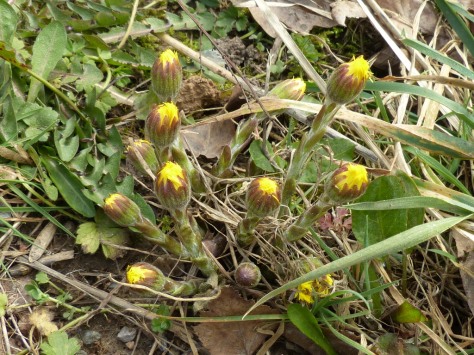 The stem is covered in long scaly bracts.
The stem is covered in long scaly bracts.
 The central disc florets are quite large and have five petals and pollen producing anthers. They have no female part and they do not produce a seed.
The central disc florets are quite large and have five petals and pollen producing anthers. They have no female part and they do not produce a seed.
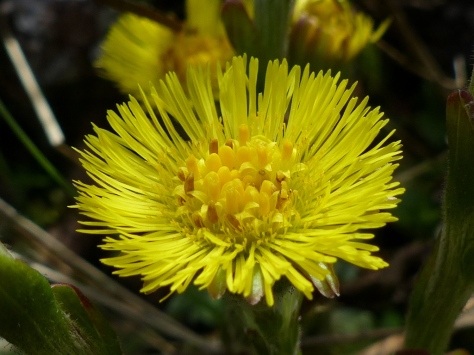 The ray florets are female, they each have a two lobed stigma to collect pollen which leads down to the ovary, where the seed will be produced.
The ray florets are female, they each have a two lobed stigma to collect pollen which leads down to the ovary, where the seed will be produced.
 Flowers of the Daisy family don’t have sepals. Instead many of them have a small ring of hairs, above the ovary, that will develop into the pappus or parachute that will carry the seed on the wind. Not all of them, neither Daisies nor Sunflowers develop parachutes but Coltsfoot does.
Flowers of the Daisy family don’t have sepals. Instead many of them have a small ring of hairs, above the ovary, that will develop into the pappus or parachute that will carry the seed on the wind. Not all of them, neither Daisies nor Sunflowers develop parachutes but Coltsfoot does.
 Very often the newly formed seed head will carry the remains of the flowers amongst it.
Very often the newly formed seed head will carry the remains of the flowers amongst it.
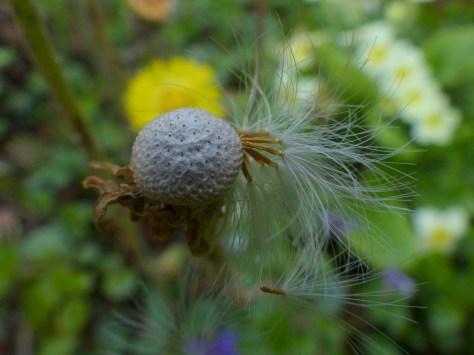 When the flowers have gone then the leaves appear, almost like a second plant and this will be one that does not appear to ever flower.
When the flowers have gone then the leaves appear, almost like a second plant and this will be one that does not appear to ever flower.
 This is the shape that gives the plant the name Coltsfoot.
This is the shape that gives the plant the name Coltsfoot.



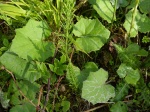 The Latin name Tussilago comes from the words Tussil (cough) and ago (act on). It was once believed that smoking the leaves would cure a cough and the plant is occasionally referred to as English Tobacco or various other smoking related names. (It should be remembered that Tobacco itself was once hailed as a remedy for respiratory ailments)
The Latin name Tussilago comes from the words Tussil (cough) and ago (act on). It was once believed that smoking the leaves would cure a cough and the plant is occasionally referred to as English Tobacco or various other smoking related names. (It should be remembered that Tobacco itself was once hailed as a remedy for respiratory ailments)
The flowers have also been used in herbal medicine and are still available to buy as ready prepared syrups and so on, however we now know that the plant contains compounds that cause severe liver problems over time and are very dangerous to children. There is a variety developed in Germany called Tussilago farfara ‘Wien’ that has had the dangerous compounds removed, it was developed after several severe cases of liver damage and the death of one child whose mother took Coltsfoot during pregnancy. It should be taken with caution.
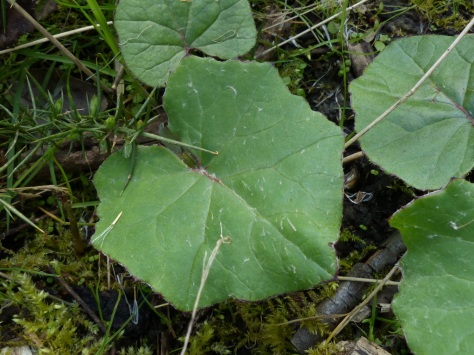 Wildlife fare better. There is a cup of nectar at the base of each ray floret and the discs are full of pollen. It is a favourite of Honey bees, one study has reported that 51% of all visits to the flower were by Apis mellifera (European Honey Bee). It flowers in early spring and these early nectar sources are very important to all of our insects.
Wildlife fare better. There is a cup of nectar at the base of each ray floret and the discs are full of pollen. It is a favourite of Honey bees, one study has reported that 51% of all visits to the flower were by Apis mellifera (European Honey Bee). It flowers in early spring and these early nectar sources are very important to all of our insects.
 Although insect pollination and seed production is vital to the plants survival most of the seeds produced will fail. Carried by the wind they must settle somewhere they will have a constantly damp environment. Such seeds allow the plant to colonise new areas but most new plants arise from vegetative reproduction (A new plant growing from the roots of an existing one) which is why you will usually find Coltsfoot flowering in quite dense groups.
Although insect pollination and seed production is vital to the plants survival most of the seeds produced will fail. Carried by the wind they must settle somewhere they will have a constantly damp environment. Such seeds allow the plant to colonise new areas but most new plants arise from vegetative reproduction (A new plant growing from the roots of an existing one) which is why you will usually find Coltsfoot flowering in quite dense groups.
Kingdom: Plantae
Order: Asterales
Family: Asteraceae
Genus: Tussilago
Species: Tussilago farfara
